By going through these Maharashtra State Board 12th Science Biology Notes Chapter 7 Plant Growth and Mineral Nutrition students can recall all the concepts quickly.
Maharashtra State Board 12th Biology Notes Chapter 7 Plant Growth and Mineral Nutrition
Plant Growth-
1. Growth is a characteristic feature of living organisms.
2. Aspects of Growth
- Quantitative
- Qualitative
Quantitative: Increase in length size, volume, numbers body mass, dry weight, etc.
Qualitative
- Change in nature of growth
- Development – orderly progress
- Differentiation – complex state
3. Growth : A permanent irreversible increase in the bulk of an organism, accompanied by change in the form.
![]()
4. Growth in multicellular/vascular plants
- Indeterminate
- Indefinite
- Restricted to specific regions
Meristems -Apical, Intercalary and lateral.
5. In unicellular plants, determinate and uniform growth is observed, while in multicellular plants certain organs like leaf, flowers and fruits show determinate growth.
Phases of growth-
1. Phase of cell division/cell formation :
- Meristematic cells – thin walled cells
- Mitotic division → 2 cells → out of these one remains meristematic and other undergoes differentiation.
- Slow rate of growth – i.e. Lag phase
2. Phase of cell enlargement/cell elongation :
- Newly formed cell absorbs water and becomes turgid.
- Osmotically active cell → Turgidity leads to cell enlargement
- Synthesis of new wall material
- Accelerated pace of growth – Log phase or exponential
3. Phase of cell maturation / Cell differentiation :
- Enlarged cell become specialized
- Cells attain maturity – morphological and physiological features
- Cells get equipped to perform specific function
- Steady state, rate of growth slow down -stationary phase
Conditions for growth-
1. Physiological conditions

2. Environmental Conditions

Growth rate and types of growth –
1. Growth in plants can be measured as increase in

2. Various methods for measurement of linear growth :
- Direct method : Measurement with scale
- Horizontal microscope : Useful for measuring growth in fields.
- Auxanometer : For linear growth of shoot – 2 types – Arc auxanometer and Pfeffer’s auxanometer.
- Crescograph : Record of primary growth, information of growth per second. It is developed by Sir J. C. Bose.
3. Growth Rate/Efficiency index : Increased growth per unit time. e.g. Increase in area of leaf, size of flower, etc.
4. Absolute growth rate (AGR) : Ratio of change in cell number (dn) over time interval (dt)
i. e. AGR = \(\frac{d n}{d t}\) i.e. total growth per unit time.
5. Relative growth ratio (RGR) : AGR when divided by total number of cells present i.e. growth of given system i.e. RGR = \(\frac{\mathrm{AGR}}{n}\)i.e. ratio of growth in given time / initial growth.
6. For describing cell growth in culture AGR and RGR are useful.
7. Types of Growth
- Arithmetic
- Geometric:
Arithmetic
- Rate of growth constant hence linear curve
- e.g. elongation of root
- Mitosis of cell → 2 cells one divides further and other differentiation and maturation
- Mathematical expression Lt = L0 + rt
Where Lt = Length at time ‘t’
L0 = Length at time zero
r = Growth rate
t = Time of growth
Geometric:
- Rate of growth slow initially and then exponential rate. J shaped curve.
- e.g. Embro – Initial stages of zygote division
Mitosis of cell → 2 cells
Both cells continue to divide and
redivide - Mathematical expression
W1 = W0ert
Where W1 = Final size
W0 = Initial size
e = base of natural log
r = Growth rate
t = time of growth.
![]()
Growth curve-
- Graphic representation of the total growth against time is known as growth CurVe.
- Types of Growth curve – Graphs
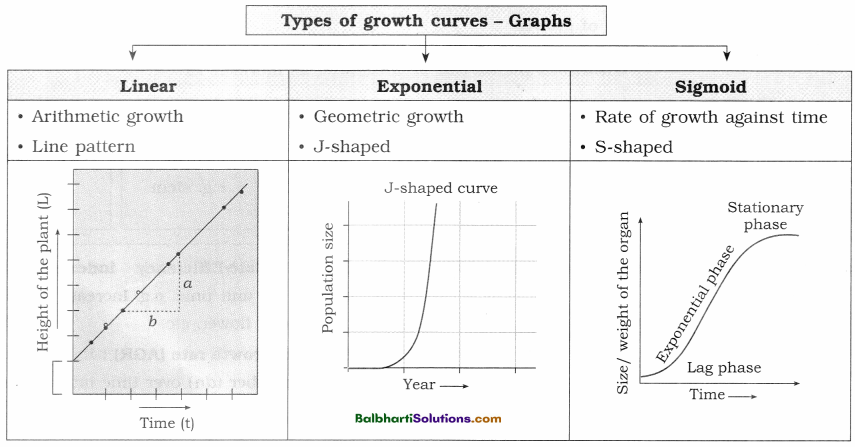
- Growth rate is low in lag phase, faster growth rate reaching maximum in exponential or log phase and is gradually slows down in stationary phase. –
- Sigmoid curve is obtained when rate of growth plotted against time for all three phases.
- Grand period of growth (GPG) : The total period required for all phases (Lag, log and stationary) to occur is called grand period of growth.
Differentiation, De-differentiation, Re-differentiation-
1. Differentiation : It is the permanent change in structure and function of cells leading to maturation.
- Maturation of cells derived from apical meristems.
- Major anatomical and physiological changes occur.
2. De-differentiation : It is a process or ability where living differentiated cells regain the capacity to divide thus permanent cells become meristematic. e.g. Cork cambium, Parenchyma cells forming interfascicular cambium for secondary growth.
3. Re-differentiation : The de-differentiated cells lose their capacity to divide and mature for the specific function, e.g. Secondary xylem and secondary phloem formed from de-differentiated cambium.
Development-
- It is an orderly process of progressive changes in shape, its form and also complexity.
- In plant it includes all sequential events in its life cycle, viz. – Seed germination → Meristem → Cell division → Plasmatic growth → Cell elongation → Cell maturation → Mature cell → Senescence → Death
- Thus growth, morphogenesis, maturation and senescence are included in development.
Plasticity-
- Plasticity : It is capacity of being moulded or modelled.
- In plants, plasticity is ability to form different types of structures in response to external environmental stimuli or internal stimuli. (Intrinsic plasticity)
- Plasticity is noticed in various phases of life. e.g. different form’s of leaves in same plant – cotton, coriander, larkspur (Delphinium) i.e. heterophylly in juvenile and adult stage.
- Environmental Plasicity is observed in Butter cup (Ranunculus Flabellasis).
Heterophylly where aquatic habitat has dissected leaves and in terrestrial habitat broadly lobed leaves.
Growth Hormones-
- Starling coined the term hormone in animal physiology.
- Growth Regulators or Growth Hormones – These are the internal factors which influence growth i.e. inhibit, promote or modify growth.
- Growth Harmones:
| Growth promoters | Growth inhibitors | Growth regulators |
| Auxins Gibberellins (GA) Cytokinins (CK) | Ethylene (gaseous) Abscissic acid (ABA) | All phytohormones |
- Plant hormones are organic substances produced naturally that affect growth or other physiological functions at a site away from their place of production.
- To evoke the response hormones are needed in very small amount and they are mainly transported through phloem parenchyma.
![]()
6. Auxins : Term given by F.W. Went
- First isolated from human urine, while in plants synthesised in apical meristematic region.
- LAA – i.e. Indole 3 acetic acid – most common natural auxin, synthesised from amino acid Tryptophan.
- Synthetic auxins – IBA (Indole butyric acid), NAA (Naphthalene acetic acid), 2, 4-D (dichloro Phenoxy acetic acid).
Physiological effects and applications of auxins :
- Cell elongation and cell enlargement
- Apical dominance – Growing apical bud inhibits growth of lateral buds
- Stimulation of growth of root and stem
- Multiplication of cells hence utilized in tissue culture
- Formation of lateral and adventitious roots
- 2, 4-D is selective herbicide – kills dicot weeds
- Induced parthenocarpy – seedless grapes, : banana, lemon, orange
- Promote cell division and early differentiation I of vascular tissue xylem and phloem.
- Induces early rooting in cutting method of : artificial vegetative propagation.
- Foliar spray of synthetic auxins – Flowering ; induced in litchi and pineapple, prevents : early fruit drop of apple, pear and oranges, prevents formation of abscission layer.
- Increase in rate of respiration.
- Break seed dormancy and promote seed germination.
Gibberellins (GA) : Named by Yabuta and Sumuki:
- First isolated from fungus Gibberella fujikuroi by Kurasawa.
- Rice seedlings show Bakane disease with stem elongation due to this fungus infestation. ;
- Yabuta and Sumuki isolated it from fungus culture.
- Synthesised from mevalonic acid in young leaves, seeds and root, stem tips.
- GA3 is most common and biologically active – Contains gibbeane ring.
Physiological effects and applications of Gibberellins :
- Breaking of bud dormancy, seed dormancy,
- By promoting synthesis of amylase in cereals, their seed germination can be stimulated e.g. wheat, barley.
- Increase in length of internodes thereby elongation of stem.
- Bolting in rosette plants – elongation of internodes before flowering e.g. Cabbage, beet.
- Parthenocarpy in tomato, apple, pear.
- Stimulates flowering in long day plants.
- Increase in fruit size and bunch length e.g. grapes.
- Overcomes effects of vernalization.
- Inhibition of root growth, delay senescence and abscission. .
- Production of male flowers on female plants.
- They convert genetically dwarf plants to phenotypically tall plants e.g. maize.
Cytokinin : Term coined by Letham.
- Promote cell division – Natural source – Banana flowers, apple and tomato fruits.
- Discovered by Skoog and Miller in Callus culture of Tobacco – by supplementing media with coconut milk.
- Present in herring (fish) sperm DNA – Kinetin.
- Cytokinins are derivatives of adenine, a purine base. Chemically 6-furfuryl amino purine.
- First natural cytokinin obtained by Letham from maize grain Zeatin.
- Synthetic hormone – 6 benzyl adenine.
- Important in plant tissue culture (callus) for morphogenesis.
Physiological effects and applications of cytokinin :
- Promote cell division and cell enlargement
- Promote shoot formation, buds
- Cytokinin and auxin ratio controls morphogenesis.
- Growth of lateral buds, controls apical dominance
- Delay of ageing and senescence, also abscission
- Formation of interfascicular cambium
- Breaks dormancy, promotes germination
- Reverse apical dominance effect
- Induce RNA synthesis
![]()
9. Ethylene : Denny reported effect in fruit ripening.
- Gane reported natural synthesis of this gaseous hormone in plants.
- Synthesised in roots, shoot apical meristems and fruits during ripening.
- It is an unsaturated, colourless, hydrocarbon gas
- Commercially used source – Ethephon
- Described as ripening hormone.
Physiological effects and applications of ethylene :
- Promotes ripening of fruits
- Stimulates initiation of lateral roots
- Breaks dormancy of buds and seeds.
- Acceleration of abscission activity by forming abscission layer.
- Inhibits growth of lateral buds, i.e. apical dominance.
- Retardation of flowering.
- Enhancement of senescence.
- Epinasty – Drooping of leaves and flowers e.g. Pineapple.
- Degreening effect – Stimulate activity of enzyme chlorophyllase causing loss of green colour in fruits of Banana, Citrus.
Abscissic Acid :
- Responsible for shedding of cotton balls and was named as abscisin I and II by Carns and Addicott.
- Isolated from buds of Acer that causes bud dormancy, substance named Dormin by Wareing.
- These substances were renamed abscissic acid, chemically 15 – C sesquiterpenoid – synthesised from mevalonic acid.
- Leaves, fruits, roots, seeds synthesise this.
Physiological effects and applications of ABA :
- Promote abscission of leaves – beneficial for stress – drought
- Induces dormancy in buds and seeds.
- Accelerates senescence of leaves, flowers and fruits.
- Delay of cell division, cell elongation and suppression of cambial activity – Inhibit mitosis.
- Causes efflux of K ions from guard cells and thus closure of stomata – used as
antitranspirant. - Stress hormone – Overcome stress by inducing dormancy, inhibiting growth thus face adverse environmental conditions.
- Inhibit flowering in long day plants and stimulate flowering in short day plants. Inhibits growth stimulated by gibberellin.
Photoperiodism-
1. Influence on Reproductive Growth –

Flowering :
- Environmental factors
- Nutritional factors
Environmental factors:
- Light -> Photoperiodism factors
- Temperature -> Vernalization
2. Effects of Light
Processes affected:
- Seed germination
- VegetatIve growth
- PhotosynthesIs
Mode/manner/aspect:
- Quality of light
- Intensity of light
- Duration of light
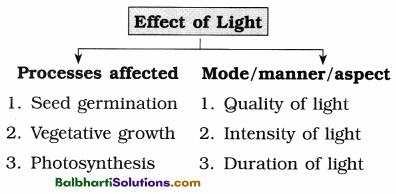
3. Photoperiodism – Term coined by Garner and Allard.
4. Duration of light has a major effect on flowering.
5. Response of plants to the relative length of light and dark periods with reference to flower initiation is called photoperiodism.
6. Critical photoperiod : It is that duration of photoperiod above or below which flowering occurs.
7. Classification of plants based on photoperiodism:
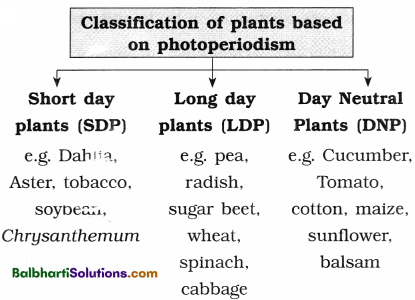
![]()
8. Short Day Plants (SDP) or Long night plants Winter flowering
- Show flowering when day length is shorter than the critical photoperiod.
- These plants need long uninterrupted dark period.
- Flowering in SDP is affected if the dark period is interrupted even by short duration (Flash : of light).
9. Long Day Plants (LDP) or Short night plants : Summer flowering
- Show flowering when longer duration of light than the critical photoperiod.
- These plants need short dark period.
- Flowering is observed if long dark period is interrupted by brief light exposure (flash).
10. Day neutral plants (DNP) :
- Flowering in these plants is independent of duration of light.
- No requirement of specific dark or light period.
- Flowering is observed throughout the year.
11. Phytochrome : Discovered by Hendricks and ; Borthwick.
- Pigment system in plants that receives the stimulus for photoperiodism.
- In short day plants, flowering is not observed if dark period is interrupted by brief exposure to red light of 660 nm but if it is exposed immediately to far red light of 730 nm flowering is observed.
- Proteinaceous pigments present in leaves.
- Exist in two interconvertible forms Pr and Pfr.
- Pfr absorbs far red light and it is changed to Pr and when Pr absorbs red light it is changed to Pfr (biologically active form).
- Phytochromes are situated in cell membrane of chlorophyllous cells of leaves.
12. During day time Pfr accumulates in leaves and stimulates flowering in LDP but inhibits flowering in SDP
13. During night (dark) Pfr converted to Pr ‘and stimulate flowering in SDP but inhibits flowering in LDP
14. In plants, morphogenesis is controlled by both light and phytochromes and hence it is known as photomorphogenesis.
15. Photoperiodic stimulus is chemical stimulus called florigen which is hormonal in nature and is transported through phloem.
Vernalization-
- It is influence of low temperature on flowering in plants. The term vernalization was coined by Lysenko.
- Temperature influences several physiological processes and reproductory growth i.e. flowering.
- Klippart observed low temperature or chilling treatment is responsible for stimulus of early flowering.
- The seeds or seedlings are exposed to low temperatures of 1 – 6° C for about a month’s duration.
- The shoot apical meristem receives stimulus in seedlings.
- Effective in seed stage (embryo) for annual plants. Cereals and crucifers show response to low temperature pretreatments.
- The stimulus is in the form of chemical substance which is proved by grafting experiment by Melcher. It is Vernalin.
- Devernalization : It is reversal of vernalization by high temperature treatment.
Advantages:
- Crops can be produced earlier.
- Cultivation of crop possible where they do not occur naturally.
Mineral Nutrition-
1. Minerals are required by plants for synthesis of food material, i.e. inorganic substances are raw materials.
2. Soil is chief source : Solid, inorganic materials are obtained from earth’s crust.
3. Air and water are other sources from surroundings.
4. Minerals are absorbed in dissolved form usually through roots.
5. Sources of minerals :
- Atmosphere : Carbon as Carbon dioxide, Oxygen
- Water : Hydrogen, Oxygen
6. C, H, O are non-mineral major elements, structural components.
7. Classification of minerals – Based on need
- Essential
- Non-Essential
Essential
- Without these life cycle of plants cannot be completed.
- Important structural and functional (physiological role)
- Their unavailability causes major deficiency symptoms. e.g. C,H,O,N,R
Non-Essential
- Not indispensable for completion of life cycle.
- Do not produce or cause major deficiency.
- Needed only at specific time during growth. E.g. Bo, SI, Al
![]()
8. Classification based on requirement – quantity
- Mac roelements
- Microelements
Mac roelements:
- Major elements
- Required in bulk or in large amounts
- Important role in nutrition
- Structural componcnts
e.g. CalcIum — Ca (cell vall)
e.g. C, H. O. R N, K, Mg. S.
Microelements:
- Minor elements
- Required in traces or small amounts
- Role as cofactors
- Act as Catalysts, activators
e.g. Zn, Cu, Al, SI, Mn, B.
9. Recent classification is based on their functional role, i.e. on the basis of biochemical functions.
10. Symptoms of Mineral deficiency in plants :
Any visible deviation from the normal structure and function of plant is called symptom.
11. Critical concentration : Required amount or the concentration of essential element below which plant growth is retarded or affected is called critical concentration.
12. Indication of deficiency is in the form of morphological changes. It may be related to the mobility of the element in the plant body.
13. Important symptoms visible in plants :

14. Role of Mineral Elements in Plants :

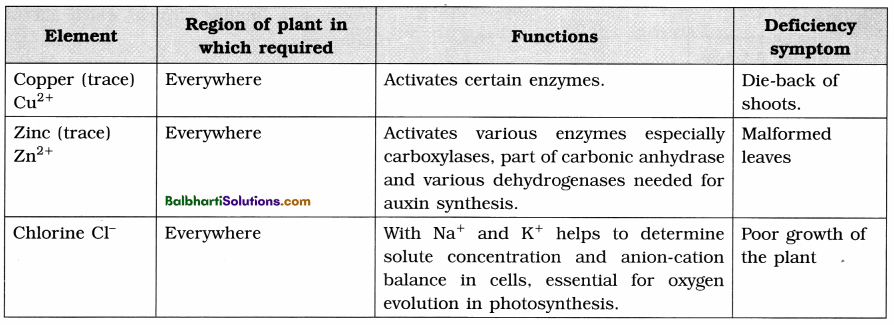
15. Toxicity of Micronutrients :
Condition of toxicity : When dry weight of tissues is reduced by 10% due to mineral ion concentration it is considered as toxic to plant.
16. Uptake of one element may be affected or inhibited by toxicity of other. For e.g. Mn competes with Fe and Mg for uptake by root system and inhibits translocation of Ca to shoot apex. It leads to deficiency of Ca, Mg and Fe.
17. Mineral salt absorption : In soil minerals exist as charged particles and mineral absorption is independent of water absorption.
![]()
18. Methods of Mineral absorption
- Passive absorption
- Active absorption
Passive absorption
- No expenditure of energy
- By diffusion
- Direct or indirect ion exchange
- Mass flow
- Donnan equilibrium
Active absorption:
- ExpendIture of energy
- Move against concentration gradient
- ATP energy from respiration
- Accumulation of ions in root hair
19. Donnan equilibrium : Some anions after their entry inside the cell get accumulated on inner side of cell membrane.
20. Additional cations are needed to balance these accumulated anions, thus the cation concentration becomes more as they get accumulated.
21. This transport from exterior against their own concentration gradient for either cations or anions is Donnan equilibrium, which is for neutralizing the effect of accumulated cations/ anions.
22. Active absorption : It needs ATP energy which is supplied to roots from respiration. Hence when there is scarcity of oxygen available to roots there is less absorption of minerals.
23. Mineral ions accumulated in root hair reach xylem through cortical cells and further along with water carried upwards.
24. They are assimilated in organic molecules and carried further with phloem to other parts i.e. redistribution.
25. A carrier concept, where membrane proteins of root cell membrane may pump these ions into cytoplasm is suggested.
Nitrogen Cycle –
- The cyclic movement of nitrogen between atmosphere, biosphere (organisms) and soil in natural processes is a nitrogen cycle.
- Nitrogen available to plants from the environment is inert and they need it in reactive form mainly nitrate ions to utilize in synthetic processes.
- Nitrogen is a limiting element which affects productivity.
- Through biological and physical fixation it is made available to plants.
- Nitrogen fixation : Conversion of free nitrogen into nitrogenous salts to make it available to plants is called nitrogen fixation.
Nitrogen Fixation-
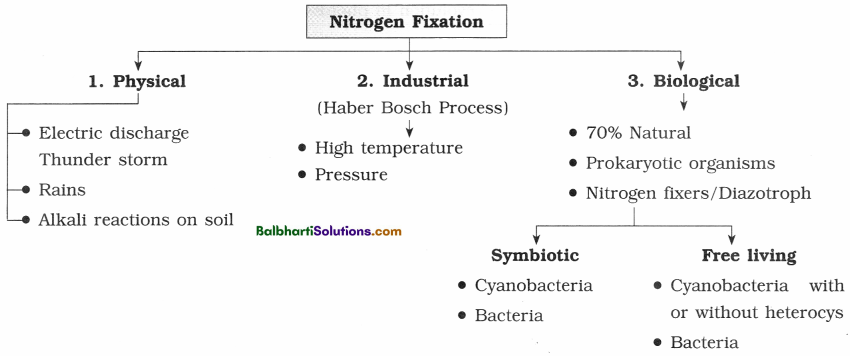
Physical nitrogen fixation – Atmosphere
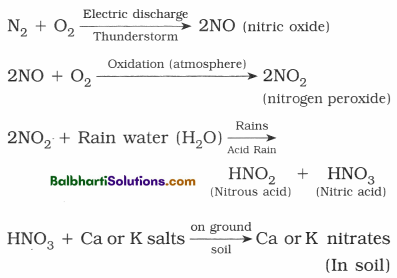
Industrial nitrogen fixation : Haber – Bosch process

- Urea is less toxic and it is used as fertilizer.
- About 80% of nitrogen found in human tissues originate from Haber-Bosch process.
Biological nitrogen fixation :
- High energy requiring process
- To fix each molecule of nitrogen to ammonia need is 16 ATE
- Ammonia is toxic it is converted to amino acids -> Proteins
Nitrification : e.g. different soil bacteria – aerobic forms – Chemoautotrophs
- Two step process
- Ammonia converted to nitrogen dioxide (nitrite) HNOa by Nitrosomonas and Nitrosococcus.
- Nitrite converted to Nitrate by addition of oxygen by bacteria Nitrobacter.
Symbiotic N2 fixation : e.g. Root nodules of Fabaceae plants – Pea, Bean, Gram, Groundnut have Rhizobium bacteria in it. Rhizobium also seen in soil.
Ammonification : e.g. Decomposers – Fungi, bacteria, actinomycetes
After death and decay of living organisms, ammonia is made available to plants and other microbes.
Nitrogen assimilation :
- Soil reservoir has nitrogen in nitrate, nitrite and ammonia (NH4–) i.e. ammonium ion.
- Uptake of these available forms from soil by plants converts and incorporates them in amino acids, nucleic acids (DNA) like organic compounds – This is assimilation.
- In the form of biomolecules Nitrogen moves through food chain and then to decomposers.
- Amino acids are transported to different parts for synthesis of required proteins.
![]()
Amino acid synthesis
- Reductive aminatlon
- Transamination
Reductive aminatlon:
- E.g. Ammonia reacting with a Ketoglutaric acid to form glutamic acid.
- Reduction reaction
Transamination:
- Glutamic acid reacting with oxaloacetic acid (OAA) to form Aspartic acid.
- Reduction reaction 2. Transfer of amino group to other Carboxylic acid
Amidation : Process of formation of amides.
- Amino acids may incorporate ammonia to produce amides. Thus these are amino acids with two amino groups.
- In presence of ATP extra amino group is attached to acidic (-COOH) group.

- Amides are transported via xylem vessels.
Denitrification : e.g. Anaerobic bacteria.
- Soil nitrates are converted to nitrogen gas.
- Denitrifying bacteria thus return back nitrogen from ecosystem to atmosphere.
- 2NO3 → 2NO2 2NO → N2↑
Nitrate → Nitrous oxide → Nitric oxide → Nitrogen gas - e.g. Bacillus spp, Paracoccus spp, Pseudomonas denitrificans.
Sedimentation : Nitrates of soil are washed away with running water or leached deep with percolating water. Thus they get accumulated and remain in the form of sediments locked and away from free circulation.